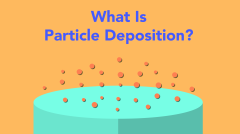As the world’s clean air experts, we talk a lot about monitoring your cleanroom’s cleanliness by keeping an eye on airborne particles. But what happens when airborne particles are no longer airborne? That is what we call particle deposition. When a particle deposits, it causes contamination and chaos in a cleanroom. So it is important to understand what particle deposition is, how it occurs, and how to minimize or prevent it in your cleanroom.
What Is Particle Deposition?
Surface particle deposition occurs when a particle deposits on a surface. Essentially, a particle moves through the air, closer to an object, until it enters the “boundary layer.” This is the layer of air directly surrounding the physical object. There are various types of mechanisms that occur which transfer the particle from the boundary layer to the surface.
In cleanrooms, we monitor particles in the air all the time. That is our main focus for monitoring cleanliness. But that means we are not able to monitor as closely for surface particles. But these particles can create contamination and disturbances in our cleanrooms, as well. Thus, we need to pay attention to particle deposition and how to prevent it in order to limit contamination in cleanrooms.
What Are The Mechanisms Of Particle Deposition?
A mechanism of particle deposition is a way that the particle passes through the boundary layer to deposit on the surface. There are eight kinds of mechanism: gravitational settling, turbulent deposition, electrostatic attraction, Brownian diffusion, impaction, interception, turbophoresis, and thermophoresis.
In order to determine the most important mechanisms in cleanrooms, we’ll be looking at a set of data developed through critical observations and experimentation. For this experiment, we used a non-UDAF cleanroom with a floor size of 6m by 4.2m. The wall height was 2.7m, and the volume was 67.5m3. A nine fan-filter unit in the ceiling supplied the air. Each fan supplied 450m3/hour. Only two fan units were used to ensure the particle deposition rate (PDR) was high enough for experiments to be completed and obtain a higher particle concentration. They supplied a total air supply of 900m3/hour and an air change rate of about 13/hour.
While we see each of these mechanisms in cleanrooms, the most important are gravitational settling, turbulent deposition, and, in some cases, electrostatic attraction. For particles smaller than about 0.5µm, Brownian diffusion also played a role.
Can You Prevent Particle Deposition?
Because particle deposition occurs when a particle transfers from the boundary layer to a surface, the way to prevent particle deposition is to stop the transfer. Thus, it is important to understand both particles and the transfer mechanisms we see the most often in cleanrooms.
Gravitational settling is when particles settle onto surfaces because of gravity’s influence. With smaller particles, this happens very slowly. For example, a 0.5µm particle will settle at a rate of about 0.0008 cm/s. As the particle size increases, the deposition velocity proportionally with the square of the particle diameter. In larger particles, this is the dominant mechanism.
The turbulent deposition occurs when air turbulence deposits particles on a surface. More particles will deposit onto a surface when there is more air turbulence.
Lastly, electrostatic attraction is when particles with oppositely-charged surfaces are pulled together. Most airborne particles and surfaces have some form of charge, so we do see this. But due to the nature of cleanroom construction, we only see it in certain situations.
So how can you prevent particle deposition?
Stop Particles From Entering The Cleanroom In The First Place
First and foremost, make sure you stop particles before they even get into the cleanroom. We often see most particles enter with humans, so double check your gowning protocols and conduct regular training. Keep your airborne particles monitored, as well, to make sure your cleanroom is staying clean. If there are no particles in the air, they can’t deposit onto surfaces and cause contamination.
Layer Surfaces Strategically
In general, cleanrooms are designed to avoid large electrostatic charges on critical surfaces. This minimizes electromagnetic particle attraction. You can also minimize attraction by using materials manufactured as electrically grounded.
Because of this, during the experiments, we found gravitational deposition to be the dominant mechanism. Because it was the primary mechanism, one could assume that a plate layered on another surface would protect the second surface. We see this method of protection often in cleanrooms.
Yet we still saw particle deposition on the bottom surface.
This is due to air turbulence above the top and bottom plates. Thus, we saw the turbulent deposition of particles onto both surfaces.
So when you are designing surfaces, it is important to recognize that the bottom plate will be protected from gravitational settling, but not electrostatic attraction or turbulent deposition. Design your cleanroom with more than just gravitational settling in mind.
Regularly Clean Surfaces
While this might not prevent particle deposition, it is an important method of handling the consequences of deposition. Particles on surfaces cause contamination and pose risks to your cleanroom contents.
Thus, use cleanroom safe products to regularly wipe down surfaces.
Become A Cleanroom Expert
Do you want to be in the know when it comes to all things clean air, cleanrooms, and particle counting? We’ve put together a library of easily-digestible information so you can be the expert in the room when it comes to cleanrooms.
You can create a free account at our Knowledge Center and start learning today!


